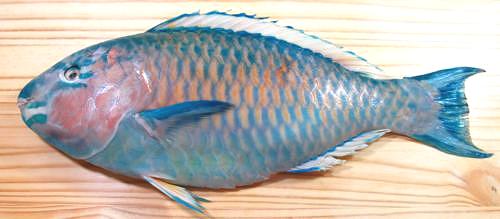 [Mol-mol, Mul-mul, Loro, Luro (Philippines); Scarus ghobban]
[Mol-mol, Mul-mul, Loro, Luro (Philippines); Scarus ghobban]
The name "Blue-barred" is a bit deceptive, because only very young fish have the three blue bars. This fish ranges throughout the Red Sea and Indian Ocean, down to South Africa, and also in the Pacific as far north as southern Japan, all through Indonesia and as far east as the Gulf of California, and down to Ecuador.
These fish can grow to almost 36 inches (TL), but the photo specimen was 18-1/4 inches long and weighed 3.33 pounds. This Parrotfish is fished commercially in various regions, and is IUCN Red Listed LC (Least Concern) - but their numbers are critically important to the health of Coral Reefs.
More on Parrot Fish.
As you can see below, Parrotfish is a little more hassle than some fish to prepare, so why deal with Parrotfish? Well, because they have a unique combination of taste and texture. Parrotfish flesh is pure white in color, with no dark strip down the center under the skin. It's flavor is mild, but sufficiently interesting to be enjoyed by the fish connoisseur - yet not so assertive as to offend those who want their fish "white and lite".
The flesh stays firm enough for any mode of cooking, but on the plate, can be flaked apart into unusually thick firm textured flakes.
Cooking: This fish needs to be cooked as skinless fillets, as its skin shrink is too severe to be controlled. For pan frying, I use just a dusting of rice flour and fry in a light oil so the true taste of the fish can be enjoyed. It also poaches very well. In both cases, use a very light sauce. This fish cooks firm enough it can be used in fish soups and stews.
Buying: Parrotfish show up fairly regularly in the Philippine fish markets here in Southern California and occasionally in other Asian markets. It's not a fish you go out to buy, it's a fish you buy when you see it. The photo specimen, 3 pounds, 5-1/4 ounces, was purchased from a Philippine fish market in Los Angeles for 2015 US $3.99 / pound.
Scales: This fish is completely covered with very large, stiff scales that have a lot of tight overlap, making them difficult to scrape off, and impossible to scrape off on a larger fish. For a 3-1/2 pound fish I had to pull them off in clumps with my long nose pliers and fingers. Fortunately, they were so big (1-1/2 inches wide), that there weren't that many of them.
Cleaning: This is not the easiest fish to clean as there are some tough membranes that aren't easy to pull out, and the gills are hard to get to. Use your long nosed pliers. You will find a set of millstones in the throat, used to crush coral pebbles into sand to extract food.
Fillet: The fish is fairly easy to fillet with an easy to follow bone structure. When you get to the rib cage, it is easiest to cut the ribs from the backbone with kitchen shears and pull them from the fillet. Pulled lengthwise they slip out easily taking almost no flesh with them. There are some substantial sharp centerline pinbones for the full length of the rib cage. Pull these out straight forward.
Skin: The skin shrinks very severely when heated, it doesn't let go, and it doesn't soften until the damage is done. Trying to hold a fillet flat when it's turned skin side down is futile, the skin just pulls the fillet into a lump. Fortunately, the skin is tough, enough to be easily removed cleanly using the long knife and cutting board Method. The skin does not have a strong or "off" flavor, but I do not use it in the stock pot because it will color the stock oddly.
Yield: Yield is moderate due to the large head and heavy structure. A 3 pound 5-1/2 ounce fish yielded 1 pound 6-1/2 ounces of skin-on fillet (42%) and 20 ounces skin off (38%).
Stock: The head, fins and bones make a fairly clear light flavored stock with almost no oil at all. It may have some color even if the skins are not used. For details see our Fish Stock page.
sf_parrbbz 151223 - www.clovegarden.com